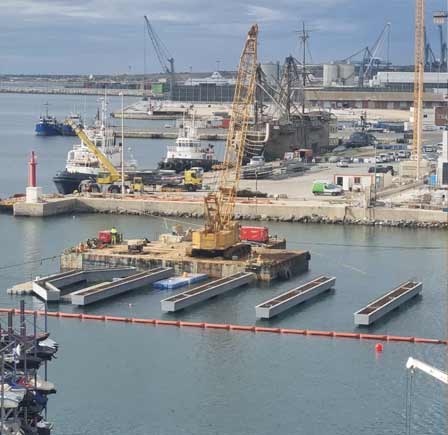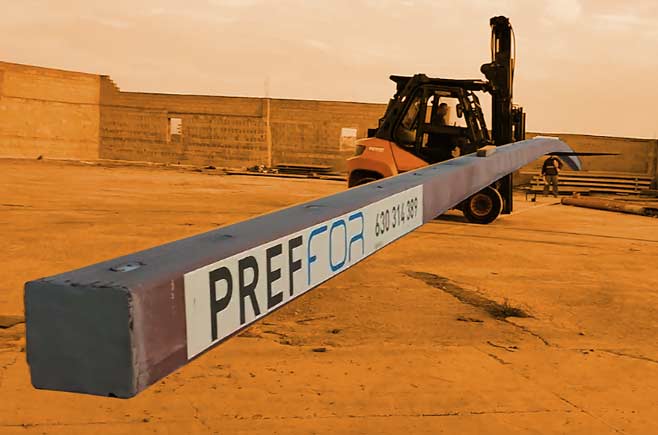In this first post of the section “UHPC World Innovation” we are going to see that innovation using UHPC is not a pipedream anymore, that innovation lies in our hands. From first UHPC structural application in 1997 in Sherbrooke, Canada, to date, several UHPC applications in civil engineering and architecture have been carried out proving the huge potential of this material. Far from being an exhaustive list of all of them, this post offers a glimpse into three applications that show UHPC greatest potential. Do you want to see them?
Over the last 20 years UHPC has been used in many different fields, such as bridges, pavements, field-cast grouted connections for prefabricated construction, mill towers, façade panels, columns, balconies, stairs, roofs, urban furniture, etc. The list of structural and non-structural applications using UHPC is almost endless nowadays.
From my experience, I am convinced that UHPC is not a material for everything, that it is not a substitute for neither conventional concrete nor steel, but may have a big market for certain applications in which it offers new possibilities. Its widespread use depends on the engineers’ ability to find those applications in which this material can fully exhibit its potential, together with a suitable design that make this possible. Even though there is still a long way to go, and even though we are not fully aware yet of all opportunities UHPC can offer, there are some applications that certainly achieved that.
In this section we will talk about those UHPC innovative applications which best take advantage of the material properties. We include three in this post.
- Sherbrooke footbridge, Canada: the first one in UHPC
- Footbridge in Guadassuar, Valencia: a competitive UHPC structure
- Applications for buildings developed by Hi-Con: high quality finishes
Sherbrooke footbridge
The Sherbrooke footbridge requires a special mention in this post as it holds the honour of being the first UHPC bridge in the world. It was built in 1997 in Sherbrook, Canada. The bridge spans 60-m and consists of a truss-type system built in six precast segments, connected by external prestressing. Construction of this bridge became a milestone in the history of UHPC, being the precursor of a vast list of bridges in the next two decades.
This innovative footbridge is owned by the Town of Sherbrooke and was design by Bouygues Construction, which also developed the UHPC used for its construction. The whole project was coordinated by Sherbrooke University and segments were made by Béton Bolduc.

Pierre-Claude Aïtcin, emeritus professor at Sherbrook University and active participant of this project wrote these marvellous words in 2000: “… as you will have noted, I am not totally objective in this field. My love of concrete is great but it is not without limits, because I know concrete too well not to realise that it is not the “only” material for the future. It is simply a marvellous material, flexible on its compositioin, ecological when we take care, and a material still full of unexplored possibilities or even unexploited possibilities“.
He realised that concrete is in a continuous evolution process. Modern concrete is not a simply mixture of cement, water and aggregates as it includes more and more other materials, such as additions (it is common to use industrial wastes), chemical admixtures, fibres, etc. Nowadays 28-day compressive strength is not as important as the ability to keep this strength along the whole life of the structure under its specific environmental conditions. Durability and sustainability have become a must in modern structures. In this context, UHPC arises as a suitable alternative to achieve that.
Footbridge in Guadassuar, Valencia
The footbridge in Guadassuar (Valencia) has a total 131.5-m total length and 3-m width and is entirely made of UHPC. The footbridge consists on 7 different truss girders with variable spans in a range from 10-m to 30-m. As it can be seen in the picture below, this is a light and slender structure of around 1.5 Ton/m. If someone saw it for his first time, he would propably think that it is a steel structure, and he would be wrong. Here lies the beauty of this footbridge, UHPC disguised as steel in a lightweight-high durability truss typology girder.

But the reason to show this one rather another does not lie on its beauty, but on its competitive if compared to traditional ones, such as steel and either reinforced or prestressed concrete. The cost of the footbridge was around 0.8 €/kg, cheaper than a kilogram of valencian oranges! That was quite cheap. This structure is a clear evidence of the huge possibilities of UHPC in civil engineering when using it properly.
This footbridge is owned by Reciclados Ribera del Xúquer, designed by RDC S.L. Click here for more detailed info.


Applications for buildings developed by Hi-Con
If there is a precasting company in Europe which has pushed the use of UHPC is Hi-Con, developing products with innovative concrete technology since 1987. They claim to be world leaders in the production of UHPC, and probably nobody can deny this fact so far. The good news is that they have survived 30 years producing elements made of special concretes, proving the great potential of UHPC if suitable designs and markets are found.
I had the pleasure to meet Bendt Aarup, material development manager at Hi-Con in the last UHPC Congress held in Kassel, 2016 and also to learn a few useful things from him. With a vast expertise behind their backs, its is not surprising that they are currently able to perform high quality products made of UHPC. As a couple of pictures are worth a thousand words, here some we have obtained from their website www.hi-con.dk.



Looking at previous pictures it would not be surprising that they serve as inspiration for architects, engineers and precasting companies. I have to admit that Hi-Con has also served as inspiration for this blog. They have their own one, which can be found in their webiste. I strongly recommend it since they talk about their own experience as a specialised UHPC precasting factory. It is a reliable and easy-reading source of knowledge.
With the brief description of the above mentioned UHPC applications, I just want to transmit one single message.
UHPC has come to stay
The way we deal with that is upon us. It would be recommendable not to ignore it, as new opportunities using this material can present itself in strange and surprising forms at any time. Look out and do not miss them.





3 Responses
Great initiative with your blog on UHPC – as you may know we are trying to do something similar, but from a different perspective. I watched the presentation on the Spanish footbridge in Montpellier and the idea is very good – to achieve a lower cost by standardizing. We have tried something similar with staircases and balconies for many years, but with no success – everyone wants unique products (at least in our field). It will be nice to follow your footbridge in a few years to see if you have better luck.
Thank you for the support! We’ll see what we can achieve in the following years!
It is very nice to see that you follow us Mr. Aarup.
In our case the main step is that the customer accepts the design we propose, because it allows us to use the same molds. Later, if they want to feel that their solution is unique they can change the colour of the UHPC, the texture of the deck or the color/effect of the glass.
I think our markets are different. In Spain the USP is the low price or, in the best case, the value for money. They can afford to have something that is not unique. Probably in your market an exclusive design is much more appreciated.
Comments are closed.